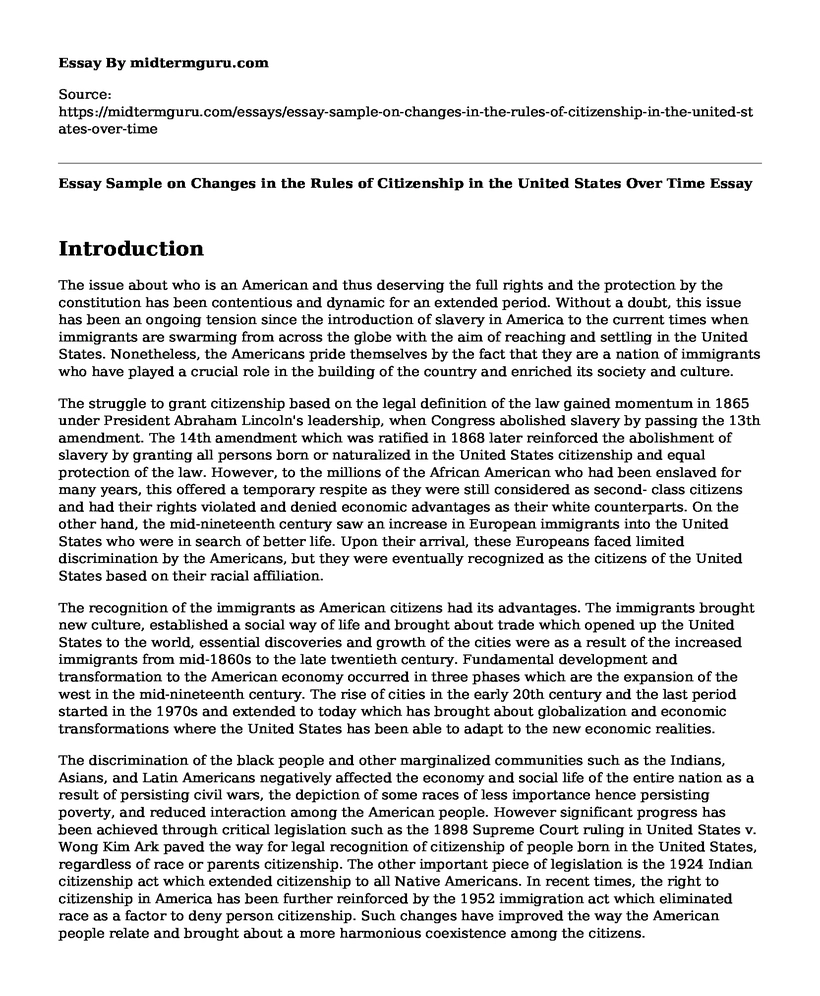Introduction
The issue about who is an American and thus deserving the full rights and the protection by the constitution has been contentious and dynamic for an extended period. Without a doubt, this issue has been an ongoing tension since the introduction of slavery in America to the current times when immigrants are swarming from across the globe with the aim of reaching and settling in the United States. Nonetheless, the Americans pride themselves by the fact that they are a nation of immigrants who have played a crucial role in the building of the country and enriched its society and culture.
The struggle to grant citizenship based on the legal definition of the law gained momentum in 1865 under President Abraham Lincoln's leadership, when Congress abolished slavery by passing the 13th amendment. The 14th amendment which was ratified in 1868 later reinforced the abolishment of slavery by granting all persons born or naturalized in the United States citizenship and equal protection of the law. However, to the millions of the African American who had been enslaved for many years, this offered a temporary respite as they were still considered as second- class citizens and had their rights violated and denied economic advantages as their white counterparts. On the other hand, the mid-nineteenth century saw an increase in European immigrants into the United States who were in search of better life. Upon their arrival, these Europeans faced limited discrimination by the Americans, but they were eventually recognized as the citizens of the United States based on their racial affiliation.
The recognition of the immigrants as American citizens had its advantages. The immigrants brought new culture, established a social way of life and brought about trade which opened up the United States to the world, essential discoveries and growth of the cities were as a result of the increased immigrants from mid-1860s to the late twentieth century. Fundamental development and transformation to the American economy occurred in three phases which are the expansion of the west in the mid-nineteenth century. The rise of cities in the early 20th century and the last period started in the 1970s and extended to today which has brought about globalization and economic transformations where the United States has been able to adapt to the new economic realities.
The discrimination of the black people and other marginalized communities such as the Indians, Asians, and Latin Americans negatively affected the economy and social life of the entire nation as a result of persisting civil wars, the depiction of some races of less importance hence persisting poverty, and reduced interaction among the American people. However significant progress has been achieved through critical legislation such as the 1898 Supreme Court ruling in United States v. Wong Kim Ark paved the way for legal recognition of citizenship of people born in the United States, regardless of race or parents citizenship. The other important piece of legislation is the 1924 Indian citizenship act which extended citizenship to all Native Americans. In recent times, the right to citizenship in America has been further reinforced by the 1952 immigration act which eliminated race as a factor to deny person citizenship. Such changes have improved the way the American people relate and brought about a more harmonious coexistence among the citizens.
Conclusion
In conclusion, despite the race being a persistence problem in the culturally diversified American nation, tremendous steps have been achieved in the recognition and protection of all American citizens under the law. The issues of racial discrimination and denial of citizenship based on the color of the skin are not as rampant as they were in the 19th and early twentieth century. However, new threats of terrorism have been a threat in recent years and have made the United States restrategize on how immigrants are allowed into the country and their citizenship application. The 2001 patriotic act is one of this amendment which aims to curb this new threat by broadening the scope of people ineligible for admission as American citizens such as people with terrorist links.
Bibliography
Bolger, Eilleen. "Naturalization Process in U.S.: Early History." Social Welfare History Project. Last modified February 21, 2018. https://socialwelfare.library.vcu.edu/federal/naturalization-process-in-u-s-early-history/.
"Defining Citizenship." National Museum of American History. Last modified July 9, 2018. http://americanhistory.si.edu/democracy-exhibition/creating-citizens/defining-citizenship.
Locke, Joseph, and Ben Wright. The American Yawp: A Free and Online, Collaboratively Built American History Textbook. 2014.
Murphy, Teresa A. "Citizenship and the Origins of Women's History in the United States." 2013. doi:10.9783/9780812208283.
Yawp. Pittsburgh, PA: Yawp Press, 2000.
Cite this page
Essay Sample on Changes in the Rules of Citizenship in the United States Over Time. (2022, Nov 02). Retrieved from https://midtermguru.com/essays/essay-sample-on-changes-in-the-rules-of-citizenship-in-the-united-states-over-time
If you are the original author of this essay and no longer wish to have it published on the midtermguru.com website, please click below to request its removal:
- Analysis of Technical Descriptions: Memo Format - Paper Example
- Research Paper on US Immigration Policy
- The Racism Continues in the US: Essay Sample
- Exploring Southwestern USA: A Rich History of Spanish, Native American and US Cultures - Essay Sample
- Attraction and Interpersonal Relationships: Exploring Social Factors - Essay Sample
- Beelow's Steakhouse: A Family Business Internship - Essay Sample
- Writing: A Powerful Tool for Meaningful Communication - Research Paper







